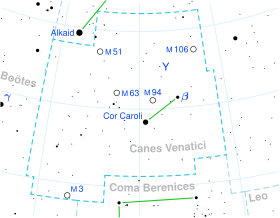La Superba
| Observation data Epoch J2000.0 Equinox J2000.0 |
|
|---|---|
| Constellation | Canes Venatici |
| Right ascension | 12h 45m 07.83s |
| Declination | +45° 26′ 24.92″ |
| Apparent magnitude (V) | +4.86 to +7.32 |
| Astrometry | |
| Radial velocity (Rv) | 15.30 km/s |
| Proper motion (μ) |
RA: -2.20 mas/yr Dec.: 13.05 mas/yr |
| Parallax (π) | 3.12 ± 0.34mas |
| Distance | approx. 1,000 ly (approx. 320 pc) |
| Characteristics | |
| Spectral type | C54J(N3) |
| U−B color index | 6.62 |
| B−V color index | 2.54 |
| Variable type | SRb |
| Details | |
| Mass | 3 (uncertain) M☉ |
| Radius | 390 R☉ |
| Luminosity | 5,800 L☉ |
| Temperature | 2,600-3,200 K |
| Other designations | |
| Database references | |
| SIMBAD | data |
La Superba (Y CVn, Y Canum Venaticorum) is a variable star in the constellation Canes Venatici, well known for its strikingly red appearance.
La Superba is a semiregular variable star, varying by about a magnitude over a roughly 160-day cycle, but with slower variation over a larger range. Periods of 194 and 186 days have been suggested, with a resonance between the periods.
Y CVn is one of the reddest stars in the sky, and it is among the brightest of the giant red carbon stars. It is the brightest J-star in the sky, a very rare category of carbon stars that contain large amounts of carbon-13 (carbon atoms with 7 neutrons instead of the usual 6). The 19th century astronomer Angelo Secchi, impressed with its beauty, gave the star its common name.
The angular diameter of La Superba has been measured at 13.81 mas. It is expected to be pulsating but this has not been seen in the measurements. At 320pc, this corresponds to a radius of 2.2 astronomical units (473 R☉). If it were placed at the position of the Sun, the star's surface would extend beyond the orbit of Mars.
La Superba's temperature is believed to be about 2800 K, making it one of the coolest true stars known. It is faintly visible to the naked eye, and the red colour is very obvious in binoculars. When infrared radiation is included, Y CVn has a luminosity several thousand times that of the Sun.
...
Wikipedia

